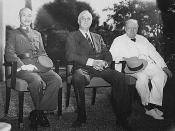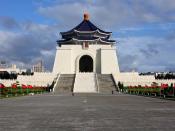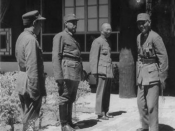When Sun Yat Sen declared the Republic of China on October 10, 1911, China embarked on 40 years of internal struggle and civil war. Warlords quickly took over sections of the country and ruled them as individual fiefdoms. Fifteen years later, in 1926, Chiang Kai Shek took control of the Kuomintang Party (as it was known in the West,) and the Army. He began a campaign to overthrow them. He was allied with the Communist Chinese until the conquest of Shanghai. By October 1928, the Communists and the Kuomintang were engaged in open warfare. From 1930 to 1934 the Kuomintang tried repeatedly to encircle Mao Zedong and his communists, driving them 6,000 miles to the Yenan Province.
Seeing China embroiled in internal strife, Japan decided to advance on Manchuria in 1931. They easily conquered the province, installed Chinese Emperor Pu-Yi and renamed it Manchukuo. Chiang was caught between the communists and the Japanese, and focused on defeating his Chinese political rivals.
In 1936 he was subjected to an abortive coup, which the Communists extricated him from in exchange for promises to fight the Japanese. Mao Zedong was getting money and supplies from the Soviet Union in response to the anti-committer pact.
The Chinese had no time to prepare. The Japanese attacked on July 7, 1937, falsifying an attack at the Marco Polo Bridge. Japanese troops and warships poured into China, attempting to occupy the five Western provinces and create another state like Manchukuo also known as Manchuria before the Japanese invasion. They occupied Peking and Shanghai. In December 1937 they took Nanjing, the Kuomintang capital. Crowded with refugees, the Nationalists abandoned Nanjing to its fate at the hands of the Japanese. Over a period of six weeks, hundreds of thousands of Chinese were killed, women were raped, and the city...


